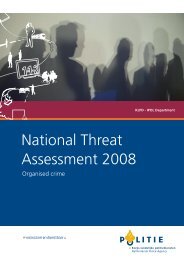Assessing the Effectiveness of Organized Crime Control Strategies ...
Assessing the Effectiveness of Organized Crime Control Strategies ...
Assessing the Effectiveness of Organized Crime Control Strategies ...
Create successful ePaper yourself
Turn your PDF publications into a flip-book with our unique Google optimized e-Paper software.
counts that tells us about <strong>the</strong> number <strong>of</strong> people convicted or amount <strong>of</strong> assets seized, as a result<br />
<strong>of</strong> some operation, are insufficient. Information is required about <strong>the</strong> economic and o<strong>the</strong>r costs<br />
involved in generating <strong>the</strong>se results, <strong>the</strong> proportion <strong>of</strong> cases initiated that result in convictions,<br />
<strong>the</strong> proportion <strong>of</strong> criminal proceeds seized and confiscated, and <strong>the</strong> extent to which criminal<br />
organizations have been disrupted by enforcement efforts. With regard to <strong>the</strong> last-mentioned,<br />
<strong>the</strong>re is considerable evidence that many OC groups are adaptable and resilient (see, for example,<br />
<strong>the</strong> discussion <strong>of</strong> headhunting and supply reduction strategies in Sections 4.2 and 4.16). Thus,<br />
evidence is required <strong>of</strong> long-term disruption <strong>of</strong> such groups. Even where this occurs, <strong>the</strong><br />
possibility that o<strong>the</strong>r groups have filled <strong>the</strong> void needs to be investigated.<br />
Ultimately, however, measures <strong>of</strong> <strong>the</strong> effectiveness <strong>of</strong> OC control efforts need to address <strong>the</strong><br />
question <strong>of</strong> whe<strong>the</strong>r <strong>the</strong> harmful activities <strong>of</strong> OC groups have been mitigated. Mastr<strong>of</strong>ski and<br />
Potter (1986:165) underscore this point about <strong>the</strong> questions that evaluations ought to address:<br />
Most important, what was <strong>the</strong> impact <strong>of</strong> <strong>the</strong>se arrests on <strong>the</strong> business <strong>of</strong> organized<br />
crime Were <strong>the</strong> <strong>of</strong>fenders’ illicit operations curtailed Were <strong>the</strong> organizations<br />
disrupted Did any disruption produce a net reduction in illicit activity, or did<br />
ano<strong>the</strong>r criminal group merely take over Without this in-formation <strong>the</strong> arrest<br />
statistics have little merit.<br />
For Mastr<strong>of</strong>ski and Potter (1986:169), OC must be conceptualized as a process and business as<br />
opposed to a static, centralized structure. They argue that <strong>the</strong>re has been excessive emphasis<br />
placed on incapacitating individuals and too little on describing <strong>the</strong> manner in which OC<br />
networks operate, launder <strong>the</strong>ir revenues, and reinvest <strong>the</strong>ir pr<strong>of</strong>its. More emphasis is needed on<br />
<strong>the</strong> manner in which criminal networks organize to meet public demand and on <strong>the</strong> way<br />
enforcement efforts influence <strong>the</strong>ir illicit activities. Research on <strong>the</strong>se and o<strong>the</strong>r process-related<br />
issues is still in its infancy.<br />
Research and Statistics Division / Department <strong>of</strong> Justice Canada | 61








